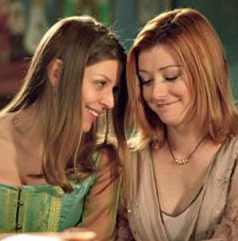The emerging world of supernatural lesbian characters.
Not since Willow Rosenberg made out with budding witch Tara on “Buffy the Vampire Slayer” has the world of lesbian sci-fi and fantasy entertainment looked so sexy. Recently, reports came out that a lesbian alien and her human partner will join the main cast of “Doctor Who.” Meanwhile, Elvis Presley’s granddaughter, Riley Keough, has been cast as a lesbian werewolf in the upcoming film “Jack and Diane.” On the TV series “True Blood,” the lesbian character Tara is now a vampire (although, to be fair, everyone on that show turns into something).
Supernatural lesbian characters are not an entirely new trend (see: Wonder Woman, lesbian vampire fiction, the film “Codependent Lesbian Space Alien Seeks Same” and “The Hunger”), but the recent deluge is a sign that more sexy aliens, vampires and werewolves are in the works. Most likely, the new trend of other-worldly lesbians is the result of two converging themes in modern entertainment: Hollywood’s obsession with anything non-human with a special power (wizards, superheroes, magic gay strippers) and the rising inclusion of gay, lesbian, bisexual or transgender characters. When the two themes merge, the supernatural/speculative lesbian character becomes a double “other.” Viewers, gay and straight alike, are drawn into the world of a character who is both non-human and non-heterosexual.
In the world of video gaming, the “double other” experience is even more profound. In the newly-released 2012 version of the video game Mass Effect 3, players have the option to choose their avatar’s sexual orientation, which may include heterosexual, homosexual, or a combination of hetero- or homo-xenophila (non-human attraction). In the history of video gaming, avatars have been limited to heterosexual relationships, which have relied on the lesbian player’s imagination. Now, if your avatar is a lesbian xenophile, you can start a romance with a female member of the Asari alien race (um… awesome).
Not to mention what a double “other” lesbian does for a film or TV show’s lesbian viewership. Take Xena and Gabrielle, for example. After show-runners upped the “ambiguous lesbian relationship” ante for the ass-kicking, supernatural duo, “Xena: Warrior Princess” became one of the highest-grossing TV series of all time. A decade or so later, “Buffy the Vampire Slayer” followed suit. When Willow went after cute lesbian witch Tara during her Freshman year of college, millions of new lesbian viewers (myself included) suddenly tuned in. We wanted to see ourselves, as well as imagine ourselves with otherworldly powers, and both shows provided that landmark experience. And for viewers who could care less about supernatural powers, they got to see a lesbian date a witch.
How awesome is that?
Lesbian aliens, vampires and werewolves may not always be marketable and entertaining to a mainstream audience, but if Atlanta’s gay and lesbian version of Comic-Con (Outlantacon) tells us anything, it’s that many of us—myself included, again—want more lesbian bang for our sci-fi/fantasy buck.
Now if only they’d bring back Willow and re-animate Tara for zombie lesbian love affair spin-off. (Sorry, too soon?)
